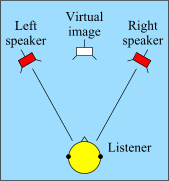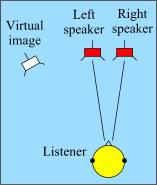|
| |
Virtual Source Imaging
|
Any
sound reproduction system that attempts to give a listener a sense of "space"
must somehow make the listener believe that sound is coming from a position
where no real sound source exists. For example, when you sit in the "sweet
spot" in front of a good two-channel stereo system, you know that it is
possible to "fill out the gap" between the two loudspeakers. If you pass
two identical signals to both loudspeakers then you will ideally perceive
the sound as coming from a position directly in front of you. If you then
increase the input to one of the speakers, the sound will be pulled sideways
towards that speaker. This principle is called amplitude stereo, and it
has been the most common technique used for mixing two-channel material
ever since the two-channel stereo format was first introduced. However,
it is intuitively obvious that amplitude stereo cannot create virtual images
outside the angle spanned by the two loudspeakers. In fact, even in between
the two loudspeakers, amplitude stereo works well only when the angle spanned
by the loudspeakers is 60 degrees or less. |
 |
|
Virtual source imaging systems
work on the principle that they "get the sound right" at the ears of the
listener. A real sound source generates certain interaural time- and level
differences that are used by the auditory system to localise the sound
source. For example, a sound source to left of the listener will be louder,
and arrive earlier, at the left ear than at the right. A virtual source
imaging system is designed to reproduce these cues accurately. In practice,
loudspeakers are used to reproduce a set of "desired" signals in the region
around the listener's ears. The inputs to the loudspeakers must be determined
from the characteristics of the desired signals, and the desired signals
must be determined from the characteristics of the sound "emitted" by the
virtual source. |
|
An example illustrates this concept. Suppose we
want to use two closely spaced loudspeakers to give a listener the impression
that sound is coming from a virtual source at a position of 45 degrees to the
left relative to straight front. This is is well outside the angle spanned by
the loudspeakers. Let us say that we want the listener to hear a short "click"
coming from that direction. If we imagine that the click is played back through
the virtual source, then we can derive, through measurements or synthesis, the
sound pressures that are produced at the ears of the listener. We refer to these
signals as the desired signals. Since the listener's torso, head, and pinnae
(outer ears) modify incoming sound waves, the desired signals do not have the
same shape as the original click. Once the desired signals are known, it is then
possible to calculate the loudspeaker inputs. This turns out to be a
surprisingly difficult problem, but it can be solved by using sophisticated
digital filter design techniques. |
 |
|
|

